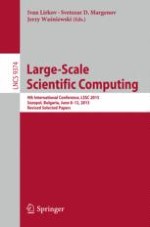This book constitutes the thoroughly refereed post-conference proceedings of the 10th International Conference on Large-Scale Scientific Computations, LSSC 2015, held in Sozopol, Bulgaria, in June 2015.
The 49 revised full papers presented were carefully reviewed and selected from 64 submissions. The general theme for LSSC 2015 was Large-Scale Scientific Computing with a particular focus on the organized special sessions: enabling exascale computation; control and uncertain systems; computational microelectronics - from monte carlo to deterministic approaches; numerical methods for multiphysics problems; large-scale models: numerical methods, parallel computations and applications; mathematical modeling and analysis of PDEs describing physical problems; a posteriori error control and iterative methods for maxwell type problems; efficient algorithms for hybrid HPC systems; multilevel methods on graphs; and applications of metaheuristics to large-scale problems.
